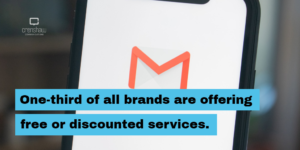COVID-19 instantly upended the way brands communicate with customers. Suddenly, most marketing was irrelevant, or worse. Some channels were simply wiped out – pity the luxury brand that had signed multimillion-dollar agreements for airport screens, for example. But most eyes were on marketing like print and TV ads that could be quickly adapted to the new situation. Messages about being together, about in-person work teams, festive crowded events, and even hugs, were scrubbed. Marketers quickly moved to recontextualize campaigns to align with our new and unexpected circumstances.
What many people didn’t think about at first was email, the most popular form of digital marketing. Major retail brands and other heavy email marketers quickly adapted to the social isolation brought on by the virus, and with good reason. The humble email is still one of the most effective channels for any business, especially now. According to HubSpot, email marketing generates $38 for every $1 spent — an ROI of 3,800%. Since the pandemic, brands are sending more emails – at least 27% more than pre-coronavirus.
And email campaigns work. According to people-based marketing platform LiveIntent, email newsletter engagement has grown during the pandemic, with particularly sharp gains for those that cover finance (43%), hard news (38%) and especially shopping (83%). Other forms of marketing may struggle, but email is chugging along as consumers stay glued to their devices while social distancing.
But what does the content of these email campaigns look like, and what can other marketers learn from them? How are brands communicating with consumers during the COVID-19 pandemic?
Our team compiled dozens of mostly B2C brand email marketing communications sent between mid-March and mid-May, analyzing copy, creative and strategy. Brands in the analysis include Dunkin’, Rothy’s, H&M, Anthropologie, Uber, Williams Sonoma, and Crate and Barrel, among others.
We found that one-third of brands offered free or discounted services, even as they expressed empathetic and encouraging words to subscribers. The deals and discounts aren’t offered in a hard-sell tone, however, but rather couched in empathetic and comforting language. A quarter of the emails spoke about being “home” or “indoors” and related to their customers being socially isolated, and/or having to work remotely. Another 20% emphasized that customers were not alone in their predicament, emphasizing words like “together” and “community.” Other emails mentioned the difficulty of these “times” (16%) and offered well wishes of “safety” (13%) and “comfort” (10%).

Empathy doesn’t only apply to the words, however. It’s also in the creative. Email marketers rushed to show customers that they understand what we’re all going through during this time. Of the 75% of the email campaigns that included images, only two campaigns didn’t include those that reflected the current environment of social distancing. Aspiration is out; comfort is in.

Subject lines averaged six words, which is fairly standard, but some campaigns featured up to 14 words in the subject line, which is far above the usual.
– 40% Off The Best WFH Styles
– Instant mood boost ? EVERYTHING BOGO $19.90
– The Everything 50% Off Stay Cozy Sale
– Stay in and Sling with free previews
– We’re all in this together
– Sending virtual hugs
– We’ve got this
– Stay safe out there, fam
– Stay strong
– Finding calm and comfort
– Who couldn’t use a little happy right now?
Clearly, every brand has been forced to reevaluate marketing messages since social isolation and unemployment have soared. They’re cognizant that irrelevant copy, or worse, inappropriate or dated emails, can turn off loyal customers and even have a negative brand reputation impact. Already, consumers show signs of growing weary of the “we are all in this together” narrative and will need more than packaged empathy to support their favorite brands in real value that includes promotion and products. Yet these changes in messaging to a “new normal” will likely be a standard for the foreseeable future.
The same is true of email as a prime customer marketing channel. Marketing may have been upended by the novel coronavirus, but email communications seems pretty pandemic-proof. As America begins to open for business again, the messages may change, but email communications is here to stay.